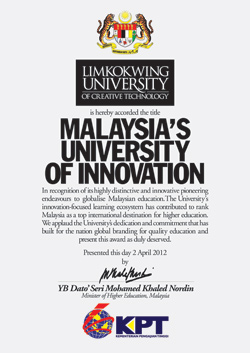That Malaysia has her heart in the right place when it comes to innovation, there is little doubt.
As a small country, surrounded by giants like India and China, we are acutely cognizant of the fact that where we lack in sheer population size, breadth, and consumer markets, we can compete by going deep into creativity and innovation.
Pervasive innovation remains elusive

When it comes entrepreneur development and innovation, Malaysia has certainly laid the groundwork with the Ministry of Science, Technology and Innovation (MOSTI) and several dedicated agencies such as Yayasan Inovasi Malaysia (YIM), Agensi Inovasi Malaysia (AIM) and the Special Innovation Unit (UNIK).
Despite different nuances about the specific eligibility to access these funds - all have the overarching goal to create awareness, train innovative entrepreneurs and develop innovations that can commercialized for the global marketplace.
These agencies are well-funded with millions of ringgit to carry out their activities, and while all have had success, much of the focus and emphasis remains very urban centred. Pervasive innovation across the breadth and width of the country remains elusive.
In 2010, the Government set up AIM with a US$100 million fund to invest in start-ups as part of broader 10-year plan to develop high-tech industries. In June this year, AIM announced it has launched 58 new innovation business opportunities (IBOs) which have a potential to generate RM1.9bil in revenue.
That same year, we worked with the Government to launch a national campaign Malaysia: Innovation Nation. The Prime Minister called 2010 the Year of Innovation.
In 2012, the Special Innovation Unit was set up under the Prime Minister's Department (UNIK) was set up. This was followed by another agency called Genovasi “to spearhead the innovation age”. It is targeted at university graduates in their 20s to undergo a ‘transformative curriculum' with the aim of developing 5,000 innovation ambassadors by 2016. The tuition fees are sponsored by AIM.
These show that innovation is high on the Government's agenda and there are many layers of funding for innovators.
However, the fact is that most Malaysians still do not know what innovation means or how it can improve their lives. Many see it as something for young people and the private sector. Those away from urban centres feel far removed from any potential impact.
If we don't address this fundamental issue, then our innovation efforts will not be pervasive enough to bring about real results for the country.
Focus on efficiency in innovation vital
Here's why that's important. In the last three years, on the Global Innovation Index, we have have moved down 1 point. In 2011, we were in number 31; in 2012 we dropped to number 32. In 2013, Malaysia's ranking was unchanged at 32nd position. Nevertheless, Malaysia scores increased from 45.90 in 2012 to 46.92 in 2013.
The GII 2013 - which was released in July this year - looked at 142 economies around the world, using 84 indicators including the quality of top universities, availability of microfinance, venture capital deals - gauging both innovation capabilities and measurable results.
Glaring in the report was in the Innovation Efficiency where we ranked No. 52 and Education, which we ranked at a dismal No. 84.
Why Innovation Must Become a National Identity
We must make innovation a national identity so that everyone feels they have a seat on this bullet train no matter their education level, their income, their job, their age.

It must be promoted pervasively. It must be broken down to a simple language so that everyone - from the taxi driver, to the housewife, to the kindergarten teacher and to the senior citizen understands they what it is, why its important, and how they can all play a part.
Whether it is grassroots or high-end innovation, enabling ecosystems must be in place, to encourage ground-breaking concepts and new directions - in classrooms and boardrooms; in factories and fisheries, in urban centers and the rural heartland.
It must be embedded into the very foundation of our education system from schools to universities, so that it becomes second nature.
There are now about ? a million tertiary students in the country. Even if 50% get onboard, that's still 250,000-strong innovative generation, compared to 25,000 over 5 years as in the Genovasi plan.
Efforts by AIM and Genovasi should be injected into every school and every government agency so that we cast a wider net and avoid any risk of making innovation top down rather than ground up.
And finally, government agencies shouldn't be competing with the higher education institutions and going into the business of innovation education.
Their role should be limited to being policy makers and implementors, a role they are uniquely perfect for.
Our model of innovation has attracted global attention

For the last 20 years, we have worked tireless to embed innovation into the University's eco system. Global agencies like the World Bank and UNESCO have acknowledged our achievements by recognising us as a New Model University for the Developing World.
We reinvented education for the developing world because the education systems we inherited from the British was irrelevant to our journey to reach 2020 as a highly developed nation.
While funding is always an important factor, there are many innovative ways such as making every University a centre for innovation.
People like us don't ask for funding; what we do need is encouragement from the Government to help us amplify our efforts.
We have been recognised by the World Bank and UNESCO for our model of education innovation.
Other countries come to ask our advice, yet at home, our expertise is largely ignored.
We must widen the net
With just 7 years to 2020,it is urgent that innovation becomes pervasive. We must widen the net and the web of innovation efforts to reach out to as many Malaysians as possible.
Clearly, we are spending a great deal of money to boost Innovation, so we need to find out where the blocks if we are to move the needle in a perceptible manner.
Clearly, coherence and alignment are key to innovation efficiency. We must streamline the operations so that we can track and measure results.
Clearly, we need to boost our competitive agility -- so that best talent can surface and the best ideas can come to fruition for the good of the nation.
 When it comes entrepreneur development and innovation, Malaysia has certainly laid the groundwork with the Ministry of Science, Technology and Innovation (MOSTI) and several dedicated agencies such as Yayasan Inovasi Malaysia (YIM), Agensi Inovasi Malaysia (AIM) and the Special Innovation Unit (UNIK).
Despite different nuances about the specific eligibility to access these funds - all have the overarching goal to create awareness, train innovative entrepreneurs and develop innovations that can commercialized for the global marketplace.
These agencies are well-funded with millions of ringgit to carry out their activities, and while all have had success, much of the focus and emphasis remains very urban centred. Pervasive innovation across the breadth and width of the country remains elusive.
In 2010, the Government set up AIM with a US$100 million fund to invest in start-ups as part of broader 10-year plan to develop high-tech industries. In June this year, AIM announced it has launched 58 new innovation business opportunities (IBOs) which have a potential to generate RM1.9bil in revenue.
That same year, we worked with the Government to launch a national campaign Malaysia: Innovation Nation. The Prime Minister called 2010 the Year of Innovation.
In 2012, the Special Innovation Unit was set up under the Prime Minister's Department (UNIK) was set up. This was followed by another agency called Genovasi “to spearhead the innovation age”. It is targeted at university graduates in their 20s to undergo a ‘transformative curriculum' with the aim of developing 5,000 innovation ambassadors by 2016. The tuition fees are sponsored by AIM.
These show that innovation is high on the Government's agenda and there are many layers of funding for innovators.
However, the fact is that most Malaysians still do not know what innovation means or how it can improve their lives. Many see it as something for young people and the private sector. Those away from urban centres feel far removed from any potential impact.
If we don't address this fundamental issue, then our innovation efforts will not be pervasive enough to bring about real results for the country.
When it comes entrepreneur development and innovation, Malaysia has certainly laid the groundwork with the Ministry of Science, Technology and Innovation (MOSTI) and several dedicated agencies such as Yayasan Inovasi Malaysia (YIM), Agensi Inovasi Malaysia (AIM) and the Special Innovation Unit (UNIK).
Despite different nuances about the specific eligibility to access these funds - all have the overarching goal to create awareness, train innovative entrepreneurs and develop innovations that can commercialized for the global marketplace.
These agencies are well-funded with millions of ringgit to carry out their activities, and while all have had success, much of the focus and emphasis remains very urban centred. Pervasive innovation across the breadth and width of the country remains elusive.
In 2010, the Government set up AIM with a US$100 million fund to invest in start-ups as part of broader 10-year plan to develop high-tech industries. In June this year, AIM announced it has launched 58 new innovation business opportunities (IBOs) which have a potential to generate RM1.9bil in revenue.
That same year, we worked with the Government to launch a national campaign Malaysia: Innovation Nation. The Prime Minister called 2010 the Year of Innovation.
In 2012, the Special Innovation Unit was set up under the Prime Minister's Department (UNIK) was set up. This was followed by another agency called Genovasi “to spearhead the innovation age”. It is targeted at university graduates in their 20s to undergo a ‘transformative curriculum' with the aim of developing 5,000 innovation ambassadors by 2016. The tuition fees are sponsored by AIM.
These show that innovation is high on the Government's agenda and there are many layers of funding for innovators.
However, the fact is that most Malaysians still do not know what innovation means or how it can improve their lives. Many see it as something for young people and the private sector. Those away from urban centres feel far removed from any potential impact.
If we don't address this fundamental issue, then our innovation efforts will not be pervasive enough to bring about real results for the country.
 It must be promoted pervasively. It must be broken down to a simple language so that everyone - from the taxi driver, to the housewife, to the kindergarten teacher and to the senior citizen understands they what it is, why its important, and how they can all play a part.
Whether it is grassroots or high-end innovation, enabling ecosystems must be in place, to encourage ground-breaking concepts and new directions - in classrooms and boardrooms; in factories and fisheries, in urban centers and the rural heartland.
It must be embedded into the very foundation of our education system from schools to universities, so that it becomes second nature.
There are now about ? a million tertiary students in the country. Even if 50% get onboard, that's still 250,000-strong innovative generation, compared to 25,000 over 5 years as in the Genovasi plan.
Efforts by AIM and Genovasi should be injected into every school and every government agency so that we cast a wider net and avoid any risk of making innovation top down rather than ground up.
And finally, government agencies shouldn't be competing with the higher education institutions and going into the business of innovation education.
Their role should be limited to being policy makers and implementors, a role they are uniquely perfect for.
It must be promoted pervasively. It must be broken down to a simple language so that everyone - from the taxi driver, to the housewife, to the kindergarten teacher and to the senior citizen understands they what it is, why its important, and how they can all play a part.
Whether it is grassroots or high-end innovation, enabling ecosystems must be in place, to encourage ground-breaking concepts and new directions - in classrooms and boardrooms; in factories and fisheries, in urban centers and the rural heartland.
It must be embedded into the very foundation of our education system from schools to universities, so that it becomes second nature.
There are now about ? a million tertiary students in the country. Even if 50% get onboard, that's still 250,000-strong innovative generation, compared to 25,000 over 5 years as in the Genovasi plan.
Efforts by AIM and Genovasi should be injected into every school and every government agency so that we cast a wider net and avoid any risk of making innovation top down rather than ground up.
And finally, government agencies shouldn't be competing with the higher education institutions and going into the business of innovation education.
Their role should be limited to being policy makers and implementors, a role they are uniquely perfect for.
 For the last 20 years, we have worked tireless to embed innovation into the University's eco system. Global agencies like the World Bank and UNESCO have acknowledged our achievements by recognising us as a New Model University for the Developing World.
We reinvented education for the developing world because the education systems we inherited from the British was irrelevant to our journey to reach 2020 as a highly developed nation.
While funding is always an important factor, there are many innovative ways such as making every University a centre for innovation.
People like us don't ask for funding; what we do need is encouragement from the Government to help us amplify our efforts.
We have been recognised by the World Bank and UNESCO for our model of education innovation.
Other countries come to ask our advice, yet at home, our expertise is largely ignored.
For the last 20 years, we have worked tireless to embed innovation into the University's eco system. Global agencies like the World Bank and UNESCO have acknowledged our achievements by recognising us as a New Model University for the Developing World.
We reinvented education for the developing world because the education systems we inherited from the British was irrelevant to our journey to reach 2020 as a highly developed nation.
While funding is always an important factor, there are many innovative ways such as making every University a centre for innovation.
People like us don't ask for funding; what we do need is encouragement from the Government to help us amplify our efforts.
We have been recognised by the World Bank and UNESCO for our model of education innovation.
Other countries come to ask our advice, yet at home, our expertise is largely ignored.

